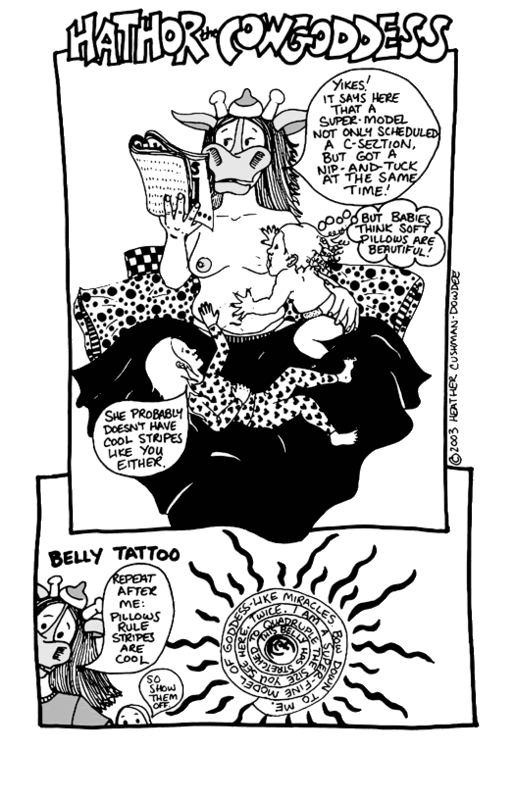I was sorting through some papers on my desk, and I flipped to a list of the Top 100 Items to Disappear First During a National Emergency. I don't remember where I found the list, but it is circulating.
Top 100 Items to Disappear First During a National Emergency
1. Generators (Good ones cost dearly. Gas storage, risky. Noisy...target of thieves; maintenance etc.)
2. Water Filters/Purifiers
3. Portable Toilets
4. Seasoned Firewood. Wood takes about 6 - 12 months to become dried, for home uses.
5. Lamp Oil, Wicks, Lamps (First Choice: Buy CLEAR oil. If scarce, stockpile ANY!)
6. Coleman Fuel. Impossible to stockpile too much.
7. Guns, Ammunition, Pepper Spray, Knives, Clubs, Bats & Slingshots.
8. Hand-can openers, & hand egg beaters, whisks.
9. Honey/Syrups/white, brown sugar
10. Rice - Beans - Wheat
11. Vegetable Oil (for cooking) Without it food burns/must be boiled etc.,)
12. Charcoal, Lighter Fluid (Will become scarce suddenly)
13. Water Containers (Urgent Item to obtain.) Any size. Small: HARD CLEAR PLASTIC ONLY - note - food grade if for drinking.
16. Propane Cylinders (Urgent: Definite shortages will occur.)
17. Survival Guide Book.
18. Mantles: Aladdin, Coleman, etc. (Without this item, longer-term lighting is difficult.)
19. Baby Supplies: Diapers/formula. ointments/aspirin, etc.
20. Washboards, Mop Bucket w/wringer (for Laundry)
21. Cookstoves (Propane, Coleman & Kerosene)
22. Vitamins
23. Propane Cylinder Handle-Holder (Urgent: Small canister use is dangerous without this item)
24. Feminine Hygiene/Haircare/Skin products.
25. Thermal underwear (Tops & Bottoms)
26. Bow saws, axes and hatchets, Wedges (also, honing oil)
27. Aluminum Foil Reg. & Heavy Duty (Great Cooking and Barter Item)
28. Gasoline Containers (Plastic & Metal)
29. Garbage Bags (Impossible To Have Too Many).
30. Toilet Paper, Kleenex, Paper Towels
31. Milk - Powdered & Condensed (Shake Liquid every 3 to 4 months)
32. Garden Seeds (Non-Hybrid) (A MUST)
33. Clothes pins/line/hangers (A MUST)
34. Coleman's Pump Repair Kit
35. Tuna Fish (in oil)
36. Fire Extinguishers (or..large box of Baking Soda in every room)
37. First aid kits
38. Batteries (all sizes...buy furthest-out for Expiration Dates)
39. Garlic, spices & vinegar, baking supplies
40. Big Dogs (and plenty of dog food)
41. Flour, yeast & salt
42. Matches. {"Strike Anywhere" preferred.) Boxed, wooden matches will go first
43. Writing paper/pads/pencils, solar calculators
44. Insulated ice chests (good for keeping items from freezing in Wintertime.)
45. Workboots, belts, Levis & durable shirts
46. Flashlights/LIGHTSTICKS & torches, "No. 76 Dietz" Lanterns
47. Journals, Diaries & Scrapbooks (jot down ideas, feelings, experience; Historic Times)
48. Garbage cans Plastic (great for storage, water, transporting - if with wheels)
49. Men's Hygiene: Shampoo, Toothbrush/paste, Mouthwash/floss, nail clippers, etc
50. Cast iron cookware (sturdy, efficient)
51. Fishing supplies/tools
52. Mosquito coils/repellent, sprays/creams
53. Duct Tape
54. Tarps/stakes/twine/nails/rope/spikes
55. Candles
56. Laundry Detergent (liquid)
57. Backpacks, Duffel Bags
58. Garden tools & supplies
59. Scissors, fabrics & sewing supplies
60. Canned Fruits, Veggies, Soups, stews, etc.
61. Bleach (plain, NOT scented: 4 to 6% sodium hypochlorite)
62. Canning supplies, (Jars/lids/wax)
63. Knives & Sharpening tools: files, stones, steel
64. Bicycles...Tires/tubes/pumps/chains, etc
65. Sleeping Bags & blankets/pillows/mats
66. Carbon Monoxide Alarm (battery powered)
67. Board Games, Cards, Dice
68. d-con Rat poison, MOUSE PRUFE II, Roach Killer
69. Mousetraps, Ant traps & cockroach magnets
70. Paper plates/cups/utensils (stock up, folks)
71. Baby wipes, oils, waterless & Antibacterial soap (saves a lot of water)
72. Rain gear, rubberized boots, etc.
73. Shaving supplies (razors & creams, talc, after shave)
74. Hand pumps & siphons (for water and for fuels)
75. Soysauce, vinegar, bullions/gravy/soupbase
76. Reading glasses
77. Chocolate/Cocoa/Tang/Punch (water enhancers)
78. "Survival-in-a-Can"
79. Woolen clothing, scarves/ear-muffs/mittens
80. Boy Scout Handbook, / also Leaders Catalog
81. Roll-on Window Insulation Kit (MANCO)
82. Graham crackers, saltines, pretzels, Trail mix/Jerky
83. Popcorn, Peanut Butter, Nuts
84. Socks, Underwear, T-shirts, etc. (extras)
85. Lumber (all types)
86. Wagons & carts (for transport to and from)
87. Cots & Inflatable mattress's
88. Gloves: Work/warming/gardening, etc.
89. Lantern Hangers
90. Screen Patches, glue, nails, screws,, nuts & bolts
91. Teas
92. Coffee
93. Cigarettes
94. Wine/Liquors (for bribes, medicinal, etc,)
95. Paraffin wax
96. Glue, nails, nuts, bolts, screws, etc.
97. Chewing gum/candies
98. Atomizers (for cooling/bathing)
99. Hats & cotton neckerchiefs
100. Livestock
With unemployment and recession hitting us at home, we were happy to have stockpiled some of our basic necessities, including grains and beans, flour, frozen and jarred veggies and fruit, olive oil, paper products, batteries, borax and baking soda, vinegar, and a number of reusable (versus disposable) products. We have put a dent in our stockpile, and need to boost it up again. I would ideally have 3 months supply of food to fall back on, if needed.
Here are a couple of useful links:
Basic food storage guide lines
http://www.trackmyfoodstorage.com/ar...eid=4&zoneid=1
Prepping guide
http://athagan.members.atlantic.net/Index.html
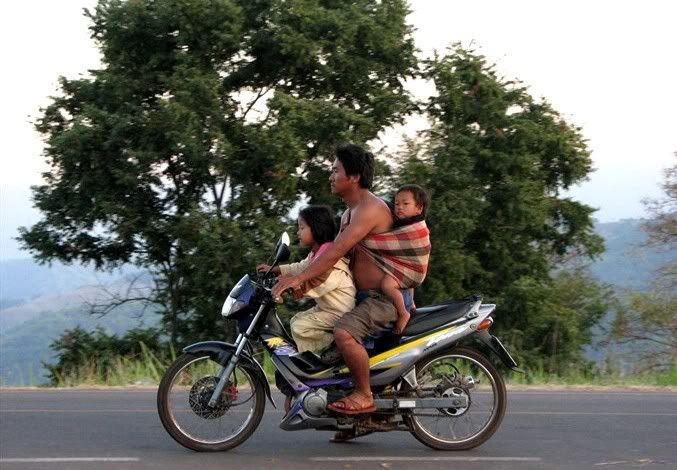 So I was reading through some of my old blog entries from a year or two ago, and I came across this picture, which I thought I would share. The photo is from Thailand, and it really made me ponder how different our cultures are.
I actually had a terrifying nightmare a while back--I could not find my ring sling. Or a pouch. Or the mai-tei. Or a moby, the ellaroo, or any long piece of fabric to tie knots in. In the dream, I grabbed a sweatshirt and tried to tie Esme to me, that's when I woke up.
So I was reading through some of my old blog entries from a year or two ago, and I came across this picture, which I thought I would share. The photo is from Thailand, and it really made me ponder how different our cultures are.
I actually had a terrifying nightmare a while back--I could not find my ring sling. Or a pouch. Or the mai-tei. Or a moby, the ellaroo, or any long piece of fabric to tie knots in. In the dream, I grabbed a sweatshirt and tried to tie Esme to me, that's when I woke up.

 The third type of carrier is the Asian-style Baby Carriers (Mei Tais, Onbuhimos, and Podaegis fall into this category). The Mei Tai is a Chinese baby carrier. It is the carrier that most closely resembles the Bjorn, though it is pretty different. It is essentially a square of fabric with waist straps and shoulder straps coming out. The square is the baby's seat, and the straps are tied around the babywearer. The Mei Tai is far more adjustable than a Bjorn and does a much better job of distributing the baby's weight over your body. You can carry much larger babies much more comfortably and in several different positions. It also holds the baby's hips in a far more ergonomic position. Onbuhimos and Podaegis tie differently but are similar to Mei Tais in many ways. Pros: easy to use, comfortable, cool for hot summer days, the two shoulder straps helps to distribute weight more evenly, easy nursing, one size fits most. Also makes for the fastest and most secure back-carry. Cons: the straps often hit the ground before you get the carrier tied (ick factor), takes more time to get baby in and out, awkward to wear without a baby inside. If you decide on an Asian-style Baby Carrier, look for one with wide straps, which are far more comfortable than narrow straps! For a while, the most sought after Mei Tai for me was Babyhawk, but I prefer Maya Wrap's Maya Tie much more! Here is a picture of me wearing Esme in a homemade Mei Tai:
The third type of carrier is the Asian-style Baby Carriers (Mei Tais, Onbuhimos, and Podaegis fall into this category). The Mei Tai is a Chinese baby carrier. It is the carrier that most closely resembles the Bjorn, though it is pretty different. It is essentially a square of fabric with waist straps and shoulder straps coming out. The square is the baby's seat, and the straps are tied around the babywearer. The Mei Tai is far more adjustable than a Bjorn and does a much better job of distributing the baby's weight over your body. You can carry much larger babies much more comfortably and in several different positions. It also holds the baby's hips in a far more ergonomic position. Onbuhimos and Podaegis tie differently but are similar to Mei Tais in many ways. Pros: easy to use, comfortable, cool for hot summer days, the two shoulder straps helps to distribute weight more evenly, easy nursing, one size fits most. Also makes for the fastest and most secure back-carry. Cons: the straps often hit the ground before you get the carrier tied (ick factor), takes more time to get baby in and out, awkward to wear without a baby inside. If you decide on an Asian-style Baby Carrier, look for one with wide straps, which are far more comfortable than narrow straps! For a while, the most sought after Mei Tai for me was Babyhawk, but I prefer Maya Wrap's Maya Tie much more! Here is a picture of me wearing Esme in a homemade Mei Tai:

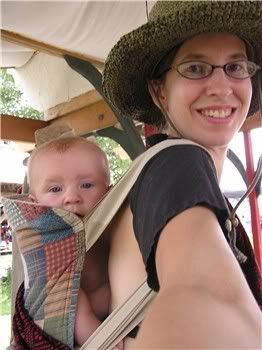
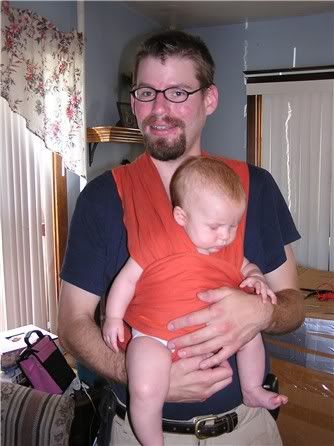



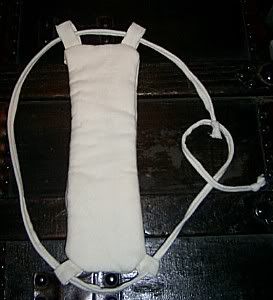
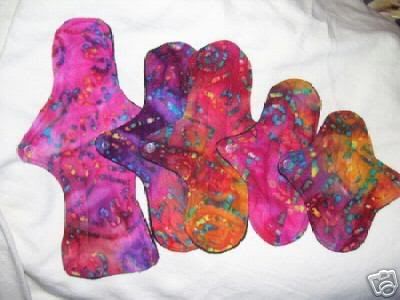
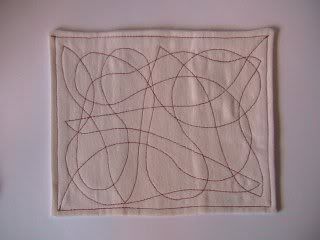
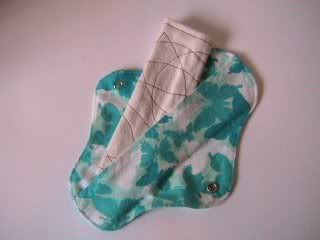
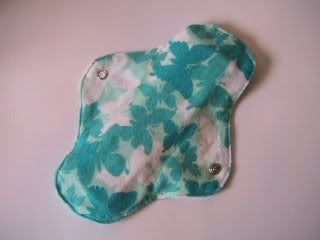
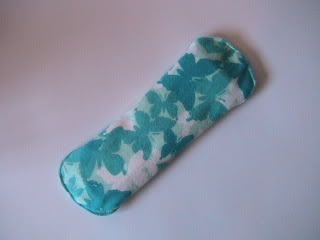
 Most of the sculptures David has done of me feature my mama tummy--and they are usually the favorites of the year when they are introduced. Done in May 2005, the following drum is the very first sculpture David did of me, what he titled "My Guardian Angel." Dispite the crack through the center in the finished version (which happened during the first firing), it is always a public favorite at shows:
Most of the sculptures David has done of me feature my mama tummy--and they are usually the favorites of the year when they are introduced. Done in May 2005, the following drum is the very first sculpture David did of me, what he titled "My Guardian Angel." Dispite the crack through the center in the finished version (which happened during the first firing), it is always a public favorite at shows:


